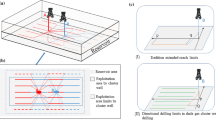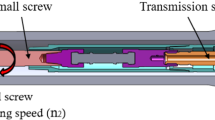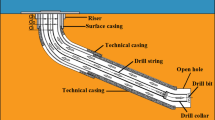Abstract
As the offshore market is facing the deepwater production challenges, the Oil and Gas Industry is investing in new technologies to bring down costs needed to effectively exploit reservoirs. Therefore, dual string drilling (DSD) can eliminate the marine riser which would result in exploring oil fields in deep and ultra-deepwater economically. In order for controlling fluid contact with a borehole wall during drilling operations include introducing an outer pipe into a borehole and positioning an inner pipe within the outer pipe axially. The method may further include circulating a drilling fluid to a drill bit using inner pipe and the annulus between the inner pipe and outer pipe. The drilling fluid may be separated from the control fluid by using an annular isolator. The results showed that with DSD approach a lot of time will be saved in order to circulate the kick out of the well. Apart from riserless drilling, DSD has an efficient cutting removal capacity, better annular clearance, elimination of differential sticking, better well stability, better well control parameters, reduction of torque and drag, avoid the dynamic equivalent circulating density gradient, and better extended reach drilling. The novelty of the new dynamics model is in the ability to solve narrow operational margin between pore pressure and fracture pressure as we move into deeper waters.


Source: Vestavik et al. (2013)



Source: ERD-new solution with a unique potential—Vestavik et al. (2013)





Similar content being viewed by others
References
Adams N, Kuhlman L (1994) Kicks and blowout control. second edition. Copyright 1980. Penn Well Publishing Company, Tulsa, p 472
Andersen EE, Cooper GA, Maurer WC, Westcott PA (1991) An analysis of relative costs in drilling deep wells. Prepared for presentation at the 66th annual technical conference and exhibition of the society of petroleum engineers held in Dallas, TX, SPE 22574, pp 1–10
Dhali MK, Biswas M (2017) Geo-hydrological response to pothole formation: a quantitative study of Kharsoti River, India. Model Earth Syst Environ 3:32. https://doi.org/10.1007/s40808-017-0280-5
Digas B, Rozenberg V, Kuklin A (2016) Application of integrated assessment model MERGE to studying ecological-economic indices. Model Earth Syst Environ 2(129):1–8. https://doi.org/10.1007/s40808-016-0187-6
Frøyen J, Rommetveit R, Jaising H (2006) Riserless mud recovery (RMR) system evaluation for top hole drilling with shallow gas. SPE 102579
Godhvan JM, Knudsen KA (2010) High performance and reliability for MPD control system ensured by extensive testing. Presented at 2010 IADC/SPE Drilling Conference and Exhibition held in New Orleans, Louisiana, USA, IADC/SPE 128222, pp 1–16
Hannegan D, Stave R (2006) The time has come to develop riserless mud recovery technology’s deepwater capabilities. Drilling Contractor, pp 50–54
Ouhibi R, Mzali H, Ghanmi M, Zargouni F (2018) Determining of a complex structure consisting of detachment, fault-bend and fault propagation folds in the collapse structure of Zaghouan-Bouficha (Bouficha region, north eastern Tunisia). Model Earth Syst Environ. https://doi.org/10.1007/s40808-018-0413-5
Peng Q, Fan H, Ji R, Chen J (2016) A simplified method of hydraulics analysis for riserless drilling system. OTC-26880-MS, pp 1–13
Rajabi MM, Nergaard AI, Hole O, Vestavik OM (2010) Riserless reelwell drilling method to address many deepwater drilling challenges. Presented at the IADC/SPE drilling conference and exhibition held in New Orleans, Louisiane, USA, IADC/SPE 126148, pp 1–7
Schubert JJ, Seland S, Johansen TJ, Juvkam-Wold HC (1999) Greater kick tolerance and fewer casing strings make dual gradient drilling a winner. IADC well control conference of the Americas, 25–26 August 1999, Houston, Texas, pp 1–31
Seyedmohammadi J (2017) The effects of drilling fluids and environment protection from pollutants using some models. Model Earth Syst Environ 3:23. https://doi.org/10.1007/s40808-017-0299-7
Shalafi M, Moradi S, GhassemAlaskari MK, Kazemi MS (2016) Drilling fluid loss control via implementing the FMI and DSI logs to protect environment. Model Earth Syst Environ 2:183. https://doi.org/10.1007/s40808-016-0241-4 1–10.
Smith D, Winters W, Tarr B, Ziegler R, Riza I, Faisal M (2010). New deepwater riserless mud recovery system opens door to deep-water dual-gradient drilling. Drilling Contractor May/June 2010
Stave R (2007) Riserless mud return technology solves shallow wellbore instability problem: a case history, Presentation to American Assoc. Drilling Engineers, pp 1–30
Stave R, Farestveit R, Hyland S, Rochmann PO, Rolland (2005) Demonstration and qualification of a riserless dual gradient system. OTC 17665, 1–11
Stave R, Fossli B, Endresen C, Rezk RH, Tingvoll GI, Thorkildsen M (2014) Exploration drilling with riserless dual gradient technology in Arctic waters. OTC 24588:1–7
Udosen NI, George NJ (2018) A finite integration forward solver and a domain search reconstruction solver for electrical resistivity tomography (ERT). Model Earth Syst Environ. https://doi.org/10.1007/s40808-018-0412-6
Utheim M (2014) Well control analysis in conventional and riserless reelwell method. Master Thesis, pp 1–80
Vestavik O, Kerr S, Brown S (2009) Reelwell drilling method. Prepared for presentation at the SPE/IADC Drilling Conference and Exhibition in Amsterdam, SPE/IADC 119491, pp 680–689
Vestavik O, Egorenkov M, Schmalhorst B, Falcao J, Roedbro M (2013) Extended reach drilling—new solution with a unique potential. SPE/IADC 163463:1–18
Acknowledgements
The authors are grateful to Pandit Deendayal Petroleum University for the permission to publish this paper. Authors are thankful to Mr. Gudendrasingh Negi for his technical advice and support.
Author information
Authors and Affiliations
Corresponding author
Ethics declarations
Conflict of interest
The authors declare that they have no competing interests.
Rights and permissions
About this article
Cite this article
Thakar, V., Nambiar, S., Shah, M. et al. A model on dual string drilling: on the road to deep waters. Model. Earth Syst. Environ. 4, 673–684 (2018). https://doi.org/10.1007/s40808-018-0457-6
Received:
Accepted:
Published:
Issue Date:
DOI: https://doi.org/10.1007/s40808-018-0457-6




